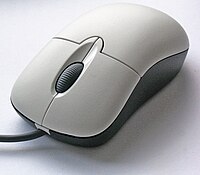
Photo from wikipedia
Attenuated tactile sensation may occur on people who have skin trauma or prolonged glove usage. Such decreased sensation may cause patients to become less responsive to minute skin deformations and… Click to show full abstract
Attenuated tactile sensation may occur on people who have skin trauma or prolonged glove usage. Such decreased sensation may cause patients to become less responsive to minute skin deformations and consequently fail to regulate their limbs properly. To mitigate such health conditions, an integrated tactile enhancement system that exceeds the human skin's sensitivity is indispensable for patients to regain the touch sensation of minute deformations. Here, we develop a visually aided tactile enhancement system for precise motion control by combining ultrathin, highly sensitive, crack-based strain sensors and signal acquisition circuit with real-time display equipment. By optimizing the thicknesses of the substrates and sensitive films of the strain sensors, our device has a detection limit as low as 0.01% and an ultrahigh gauge factor of 44 013 at a strain of 0.88%, which exceeds the performance of previous devices with crack-based strain sensors within minute strain range. The high sensitivity of the ultrathin crack-based strain sensor makes it possible for our visually aided tactile enhancement system to detect tiny deformations such as the slight brush of a feather, the fall of water droplets on fingers, and even the touch of invisible wires. Our study demonstrates promising applications of integrated visually aided tactile enhancement systems in human-machine interactions and artificial intelligence.
Journal Title: Applied physics reviews
Year Published: 2020
Link to full text (if available)
Share on Social Media: Sign Up to like & get
recommendations!